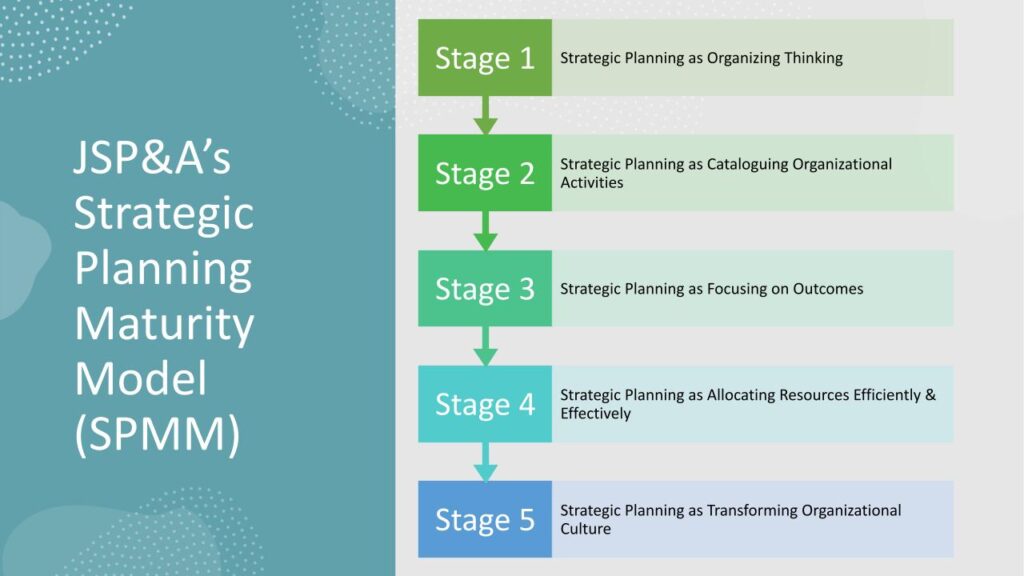The ultimate goals of a strategic plan are twofold:
- To provide a shared direction for the allocation of organizational resources and
- To provide the context for turning strategy into action.
Based on our experiences, we realized that strategic planning is a skill. It is both a skill that employees individually and an organization collectively can acquire. Once we express strategic planning as a skill, we highlight that, like any skill, there are ways to enhance an individual’s and organization’s “skill at strategic planning.” With this recognition, we have developed a strategic planning maturity model.
The JSP&A Strategic Planning Maturity Model (JSPA-SPMM) is a model of how an organization “matures” when using “strategic planning.” The strategic planning process is part of ongoing organizational transformation – reaching Stage 5.
Since strategic planning is an organizational skill, our maturity models outline the skills’ development levels an organization can reach.

Stage 1: Strategic Planning as Organizing Thinking
In Stage 1, strategic planning provides a framework to think systemically about what the organization is doing and what it would like to do. So while there are many discussions about developing a mission, a vision, and objectives, fundamentally, what is going on is that employees and stakeholders are putting their collective thinking into a shared language. So while they are taking an important step, there’s no fundamental transformation of what the organization is doing and how it is doing it.
Stage 2: Strategic Planning as Cataloguing Organizational Activities
Stage 2 is similar to Stage 1: Strategic planning provides a framework for taking the myriad of organizational activities and putting those activities into “boxes.” It provides a framework for an organization to “make sense” of its activities. Typically, this includes a mixture of existing and new activities, with a preponderance of existing ones. The organization uses the strategic planning process to understand better what it has been doing, what it is doing, and what it would like to do.
Stage 3: Strategic Planning as Focusing on Outcomes
In Stage 3, the vision, mission, objectives, and activities get tied to a set of broad “outcomes.” At this stage in the process, we introduce a performance measurement and management model to further group the activities and begin to set “numerical targets.” We frequently use a “logic model” that links the relationships between “input activities” and “process activities.” These “process activities” lead to “outputs,” and these “outputs” lead to “outcomes.”
In Stage 3, the organization gets focused on “outcomes,” the ultimate reason for its existence. Here the strategic planning process focuses on how an organization achieves “results” and what “results” it wants to achieve.
Stage 4: Strategic Planning as Strategic Allocation of Resources
Stage 4 is critically important. In many ways, the first three stages are “descriptive.” They outline what an organization is doing and what it would like to do. However, an organization has to address the “flip side” of this process. It has to decide what it will not do because resources (time and money) are limited. In one sense, Stage 4 is the key “stage” in that it requires an organization to make “trade-offs.” An organization has to decide what “to give up.” Stage 4 requires an organization to come to grips with its constraints. The “constraints” are “limiting factors.” They force an organization to invest in areas that create the most “value-added,” given the organization’s time and money. Stage 4 is when “strategic planning” really becomes “strategic.”
Stage 5: Strategic Planning as Organizational Culture
At Stage 5, “strategic planning” is no longer a periodic activity. Remember:
The ultimate goal of a strategic plan is to provide direction for allocating organizational resources and providing the context for turning strategy into action. The strategic planning process is, in part, a process of organizational transformation.
Within the DiSC® model, “organizational culture” is defined as what an organization does and how it does it. In Stage 5, “strategic planning” has become an organizational cultural norm. “Strategic planning” has become the “new normal.”
The “Everything DiSC®” leadership model embodies this as well. In this model, “we are all leaders.” And as “leaders,” we must continually hone three critical skills – vision, alignment, and execution – that reinforce one another. These skills are fundamental to effective strategic planning.
At Stage 5, individuals embody strategic planning as a way of “doing business:” There is an internal, ongoing process of refining and updating the organization’s strategic direction based on the performance information and data that provides constant feedback.
